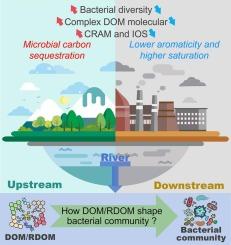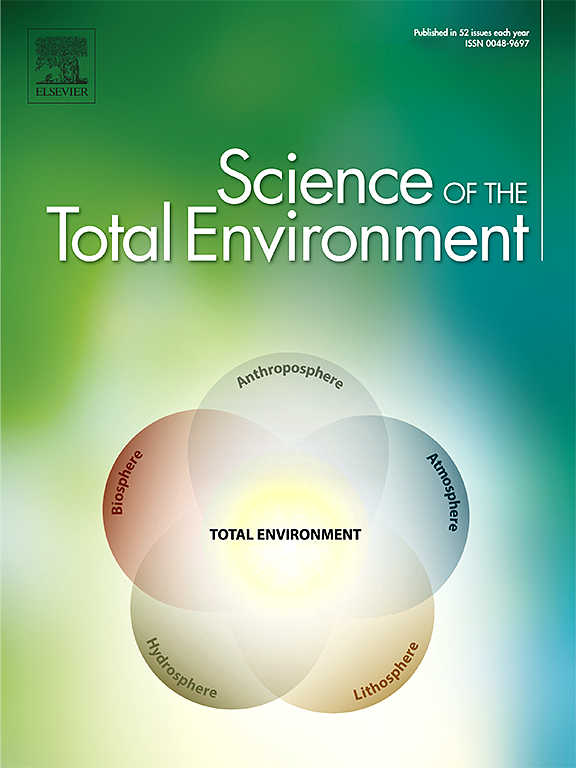评估城市化淡水生态系统中难溶解有机物在细菌群落动态中的作用。
IF 8.2
1区 环境科学与生态学
Q1 ENVIRONMENTAL SCIENCES
引用次数: 0
摘要
溶解有机物(DOM)和难溶解有机物(RDOM)在塑造微生物群落方面发挥着不同的作用。然而,确定这些作用的特征却很困难,尤其是在受到不同程度人为影响的生态系统中。本研究对山西太原汾河中 DOM 和 RDOM 的分子组成和生态影响进行了调查,并对上游原始地区和下游高度城市化地区进行了比较。利用 16S rRNA 基因测序和基于 LC-MS 的代谢组学,我们观察到微生物群落组成、多样性和代谢功能发生了显著变化。上游群落的特点是多样性较高,以类杆菌、变形菌和蓝藻为主,而下游群落受污染影响,与氨基酸代谢相关的基因表达量增加。荧光光谱法和傅立叶变换离子回旋共振质谱法(FT-ICR MS)显示,上游 DOM 含有较高比例的复杂高分子量化合物,包括大量富羧基脂环族分子(CRAM)和稳定岛(IOS)化合物,它们在长期碳储存和微生物固碳中发挥着关键作用。相比之下,下游 DOM 的特点是芳香度较低,饱和化合物较多,CRAM 和 IOS 的比例较低,反映了人为活动的影响。这些发现强调了 CRAM 和 IOS 在调节 DOM 稳定性和微生物群落中的关键作用,进一步突出了有针对性的污染控制策略对保护城市化水体生态系统功能的必要性。本文章由计算机程序翻译,如有差异,请以英文原文为准。

Evaluating the role of recalcitrant dissolved organic matter in bacterial community dynamics in urbanized freshwater ecosystems
Dissolved organic matter (DOM) and recalcitrant dissolved organic matter (RDOM) play distinct roles in shaping microbial communities. However, characterizing these roles is difficult, especially in ecosystems subjected to varying degrees of anthropogenic influence. This study investigated the molecular compositions and ecological impacts of DOM and RDOM in the Fen River, Shanxi Taiyuan, comparing pristine upstream regions with highly urbanized downstream areas. Using 16S rRNA gene sequencing and LC-MS-based metabolomics, we observed significant shifts in microbial community composition, diversity, and metabolic functions. Upstream communities, characterized by higher diversity, were dominated by Bacteroidota, Proteobacteria, and Cyanobacteria, while downstream communities, influenced by pollution, exhibited increased expression of genes related to amino acid metabolism. Fluorescence spectroscopy and Fourier transform ion cyclotron resonance mass spectrometry (FT-ICR MS) revealed that upstream DOM contained higher proportions of complex, high molecular weight compounds, including significant proportions of carboxyl-rich alicyclic molecules (CRAM) and island of stability (IOS) compounds, which play key roles in long-term carbon storage and microbial carbon sequestration. In contrast, downstream DOM was characterized as having lower aromaticity and more saturated compounds, with reduced proportions of CRAM and IOS, reflecting the impact of anthropogenic activities. These findings underscored the critical roles of CRAM and IOS in regulating DOM stability and microbial communities, further highlighting the need for targeted pollution control strategies to preserve ecosystem function in urbanized water bodies.
求助全文
通过发布文献求助,成功后即可免费获取论文全文。
去求助
来源期刊

Science of the Total Environment
环境科学-环境科学
CiteScore
17.60
自引率
10.20%
发文量
8726
审稿时长
2.4 months
期刊介绍:
The Science of the Total Environment is an international journal dedicated to scientific research on the environment and its interaction with humanity. It covers a wide range of disciplines and seeks to publish innovative, hypothesis-driven, and impactful research that explores the entire environment, including the atmosphere, lithosphere, hydrosphere, biosphere, and anthroposphere.
The journal's updated Aims & Scope emphasizes the importance of interdisciplinary environmental research with broad impact. Priority is given to studies that advance fundamental understanding and explore the interconnectedness of multiple environmental spheres. Field studies are preferred, while laboratory experiments must demonstrate significant methodological advancements or mechanistic insights with direct relevance to the environment.
 求助内容:
求助内容: 应助结果提醒方式:
应助结果提醒方式:


